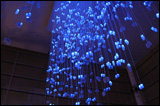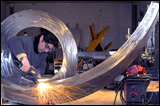Home, Sculptors, Fabricated Acrylic Sculptors, Foundries and Services, Supplies/Tools/Equipment, Miscellaneous
Acrylic - Supplies, Tools and Equipment
- Read about: How
Frederick Hart solved some of the problems of casting sculptures in
Lucite
- Midton Acrylics - Specialised Applications - The high clarity and inert nature of the
acrylic is ideal for laboratory equipment for example. Sculptures can be
reproduced with the intrinsic feature of reflected and refracted light
transmission and also the enhancement of incorporated parts or printed designs
if desired. Castings can be produced with cavities and without joints to
withstand a vigorous working environment. Solid colours and tints can be added
for visual appeal or to aid function. Additives can be mixed into the acrylic to
modify optical characteristics and metal or other parts embedded to provide
radiation screening etc. in these cases the finished part is effectively a
composite material.
- PlasticsNet.Com Where Plastics
People Do Business PlasticsNet.Com has continually grown its product
offering and supplier base, currently featuring more than 31,000 product SKUs
(including resins, materials, equipment and supplies) from companies including
General Polymers, MSC Industrial, Van Dorn, Maguire and more
- Mutant
Materials Plastics The fabulously prolific family of plastics is represented
in the show by dozens of different objects, ranging from chairs to minuscule
telephones, manufactured using a variety of techniques. Some of the most archaic
processes, such as compression molding, are particularly suitable for objects
made with recycled polymers. More sophisticated technologies, such as
injection-molding--in which granules of raw material are conditioned by heat and
pressure to reach a fluid state and then injected into a steel mold--are now
frequently employed for the common polymers polystyrene, high-density
polyethylene, polypropylene, and ABS. The techniques of calendaring and
extrusion are continuous processes in which the mold is an open-ended channel,
while in blow or rotational molding plastic is subjected to centrifugal pressure
that forces it to adhere to the mold walls. Plastics were invented in the
last century, and until the middle of this century they were used only to
imitate natural materials. Since that time, technology has brought polymers to a
very sophisticated level of formal and structural evolution. Today's plastics
are sturdy, resistant, and beautiful. They can take on many shapes, from the
most straightforward to the most articulated. No form is absolute: mutant
plastics can resemble translucent and transparent glass, they can be molded to
match the organic shapes of parts of our body, they can be treated to look like
folded, articulated plans, and they can be detailed into small, complex objects
like computer mice.
- Castolite - 4915 Dean Woodstock, Il 60098 Call 815-338-4670 to request a catalog. Acrylic for casting.

